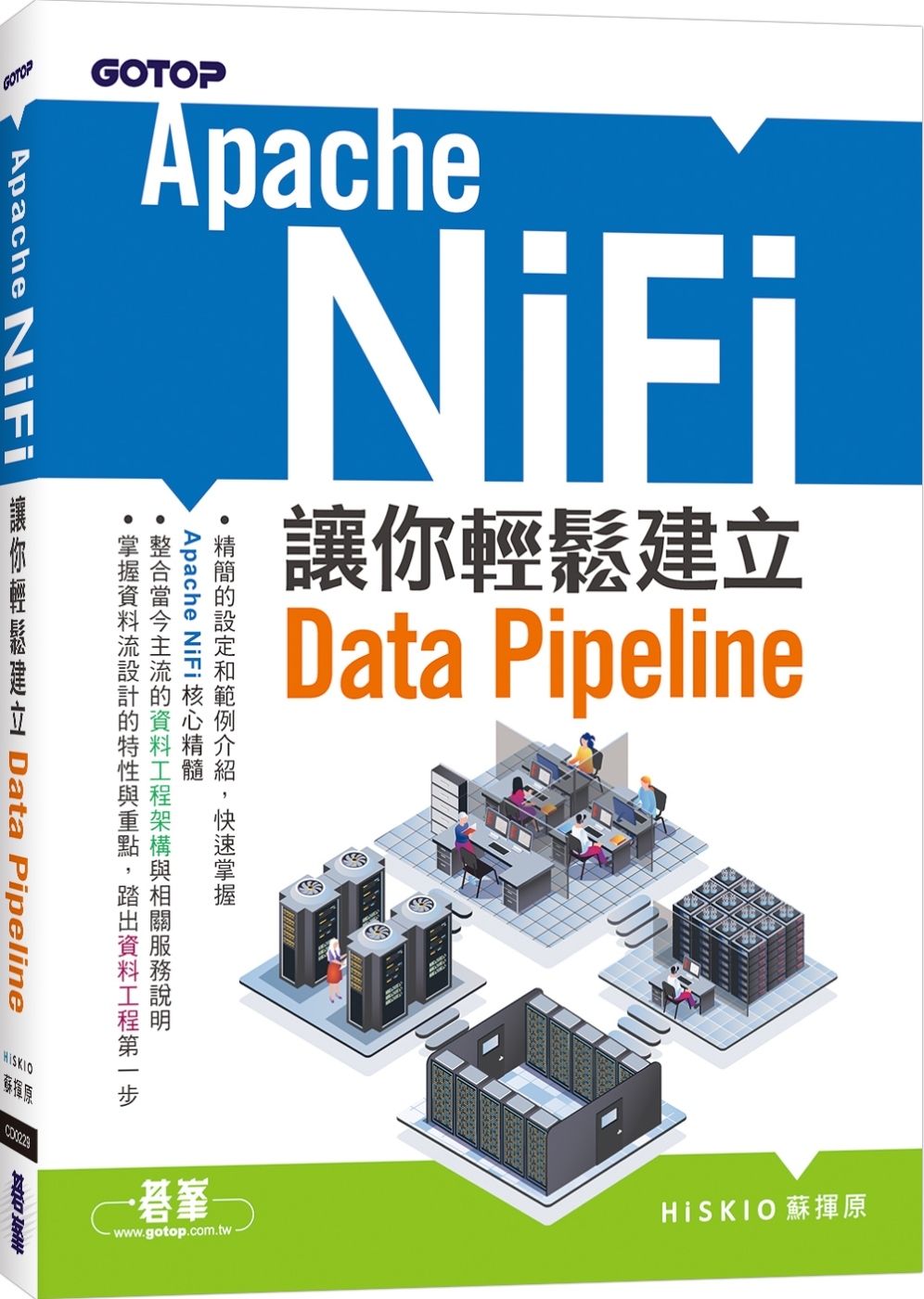章節說明:第1章 Data Pipeline 的重要性
1.1 何謂 Data Pipeline?
1.2 何謂 Streaming 和 Batch?
1.3 何謂 Lambda、Kappa 和 Delta 架構?
1.4 為什麼需要使用 Apache NiFi?
1.5 小結
第2章 Apache NiFi 的架構與建置
2.1 Apache NiFi 架構與規格
2.2 Apache NiFi Data Flow 的版控 - NiFi Registry
2.3 如何建置 Apache NiFi & NiFi Registry
2.4 小結
第3章 Apache NiFi Componenet 介紹
3.1 FlowFile 的概念與操作
3.2 Processor 的概念與操作
3.3 Connection 的概念與操作
3.4 Processor Group 的概念與操作
3.5 Controller Service 的概念與操作
3.6 Templates、Label 和 Funnel 的概念與操作
3.7 NiFi Registry 的概念與操作
3.8 小結
第4章 Apache NiFi 的語法
4.1 Variables 和 Parameters 的範圍與差異
4.2 何謂 NiFi Expression Language?
4.3 小結
第5章 Apache NiFi 和 DB 對接與實務
5.1 何謂 RDB 和 DocumentDB?
5.2 如何對 MySQL 對接與操作?
5.3 如何與 MongoDB 對接與操作?
5.4 小結
第6章 Apache NiFi 和 Message Queue 對接與實務
6.1 什麼是 Message Queue?
6.2 什麼是 Apache Kafka?
6.3 如何對 Apache Kafka 對接與操作?
6.4 小結
第7章 Apache NiFi 和 Cloud 對接與實務
7.1 如何串接 AWS 服務?
7.2 如何串接 GCP 服務?
7.3 小結
第8章 Apache NiFi 監控與追蹤邏輯
8.1 訂定適當的監控指標
8.2 Apache NiFi 的 Reporting Task 和整合應用
8.3 Apache NiFi 的基本偵錯 Alert 機制
8.4 小結
第9章 資料工程的重要性與未來
9.1 資料工程是什麼?為何重要?
9.2 未來資料工程的變化與趨勢
| FindBook |
有 5 項符合
Apache NiFi|讓你輕鬆建立Data Pipeline的圖書 |
 |
Apache NiFi|讓你輕鬆建立Data Pipeline 作者:蘇揮原 出版社:碁峰 出版日期:2023-03-24 語言:繁體中文 規格:平裝 / 264頁 / 17 x 23 x 1.55 cm / 普通級/ 單色印刷 / 初版 |
| 圖書選購 |
| 型式 | 價格 | 供應商 | 所屬目錄 | $ 406 |
其他資料庫相關 |
$ 522 |
其它資料庫 |
$ 522 |
文書應用軟體 |
$ 522 |
科學科普 |
$ 539 |
中文書 |
|---|
| 圖書館借閱 |
| 國家圖書館 | 全國圖書書目資訊網 | 國立公共資訊圖書館 | 電子書服務平台 | MetaCat 跨館整合查詢 |
| 臺北市立圖書館 | 新北市立圖書館 | 基隆市公共圖書館 | 桃園市立圖書館 | 新竹縣公共圖書館 |
| 苗栗縣立圖書館 | 臺中市立圖書館 | 彰化縣公共圖書館 | 南投縣文化局 | 雲林縣公共圖書館 |
| 嘉義縣圖書館 | 臺南市立圖書館 | 高雄市立圖書館 | 屏東縣公共圖書館 | 宜蘭縣公共圖書館 |
| 花蓮縣文化局 | 臺東縣文化處 |
|
|
圖書介紹 - 資料來源:TAAZE 讀冊生活 評分:
圖書名稱:Apache NiFi|讓你輕鬆建立Data Pipeline
內容簡介:‧精簡的設定和範例介紹,快速掌握Apache NiFi核心精髓
‧整合當今主流的資料工程架構與相關服務說明
‧掌握資料流設計的特性與重點,踏出資料工程第一步
本書介紹Apache NiFi這套服務工具,讀者可以於該服務設計自動化處理資料流(Data Pipeline)。所有的設計與設定都是以No Code與WEB UI方式處理,具備強大的操作互動性和易用性。另外支援大多數的資料載體,如:Relational Database、Document DB、Column-Based、DataWarehouse 、Message Queue等對接處理,並支援目前主流的三大雲平台-AWS(Amazon Web Service)、GCP(Google Cloud Platform)和Microsoft Azure,涵蓋大部分企業使用到的應用與服務,都可透過Apache NiFi做到一站式整合與資料流設計,確保資料處理邏輯以及流入和流出的方向和目的地。同時在面對大量資料處理時也可以運用高擴展的特性來平行執行,也能更細節地去追蹤資料的變化與狀態,最後做到完整的流程與錯誤控制以避免產生資料遺漏的窘境。
本書會介紹當今在資料工程常見的架構,接著介紹Apache NiFi的架構與元件、建置流程與設定、操作方式、與外部服務的整合和應用、資料追蹤等各個資料工程常見的應用處理。最後會提及資料工程領域的發展和重點分析,讓對於這塊領域較陌生或有興趣的讀者們,除了可以在本書學到Apache NiFi的核心價值之外,也能意識到該領域的後續發展與重點,給予讀者具體方向進行未來的發展和準備。
目錄
章節說明:第1章 Data Pipeline 的重要性
1.1 何謂 Data Pipeline?
1.2 何謂 Streaming 和 Batch?
1.3 何謂 Lambda、Kappa 和 Delta 架構?
1.4 為什麼需要使用 Apache NiFi?
1.5 小結
第2章 Apache NiFi 的架構與建置
2.1 Apache NiFi 架構與規格
2.2 Apache NiFi Data Flow 的版控 - NiFi Registry
2.3 如何建置 Apache NiFi & NiFi Registry
2.4 小結
第3章 Apache NiFi Componenet 介紹
3.1 FlowFile 的概念與操作
3.2 Processor 的概念與操作
3.3 Connection 的概念與操作
3.4 Processor Group 的概念...
1.1 何謂 Data Pipeline?
1.2 何謂 Streaming 和 Batch?
1.3 何謂 Lambda、Kappa 和 Delta 架構?
1.4 為什麼需要使用 Apache NiFi?
1.5 小結
第2章 Apache NiFi 的架構與建置
2.1 Apache NiFi 架構與規格
2.2 Apache NiFi Data Flow 的版控 - NiFi Registry
2.3 如何建置 Apache NiFi & NiFi Registry
2.4 小結
第3章 Apache NiFi Componenet 介紹
3.1 FlowFile 的概念與操作
3.2 Processor 的概念與操作
3.3 Connection 的概念與操作
3.4 Processor Group 的概念...
顯示全部內容
|









